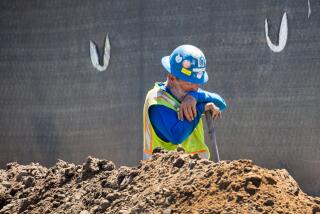Temperatures Take Off : Weather: Sunday’s heat didn’t stop model plane competition at Lake Casitas. But many people head for the beaches. Cooler days are forecast this week.
- Share via
For remote-control plane buffs, the near 100-degree temperature at Lake Casitas on Sunday was no bother at all.
But many other “inlanders,” finding the heat too oppressive, packed a picnic basket, grabbed a blanket and found a patch of sand along the Ventura County coastline, where nature’s air conditioning lowered the temperature by about 20 degrees.
However, Ventura County is about to get some respite from the dog days of summer, according to a meteorologist.
Dissipation of the uncomfortable humidity that has left residents wondering if they were living in Ventura County or in Miami is just a couple of days away, said meteorologist Stephen Burback of WeatherData Inc., which provides weather forecasts for The Times.
The model plane competition, sponsored by the Ventura County Comets, was held at a 400-foot-long airstrip at Lake Casitas.
Scale models of actual World War I and II planes and civilian aircraft, all controlled by remote radio signals, soared through loops and dives over the lake. The models, which weigh up to 20 pounds, were built up to one-third scale, with wingspans of 6 to 10 feet.
Sixteen contestants from Ventura, Santa Barbara and San Luis Obispo counties and other nearby points competed for trophies. The idea was to put the aircraft through the same maneuvers as the real planes could perform.
“It’s a fantastic hobby,” said Bennett Spencer, 65, of Ventura, the club’s president. “It’s an outlet for your creative skills and your frustrations.”
The colorful planes, such as a World War I Bristol Bullet fighter and a civilian Beechcraft Skipper trainer, took off from the airstrip and did prescribed figure eights, barrel rolls and other complicated maneuvers over the lake before returning to the mini-landing field.
Two judges scored the flights. The planes were controlled by hand-held radio transmitters, each of which had two control sticks that triggered the maneuvers.
“Similar avionic systems are used by the military for remote-piloted planes,” Spencer said.
Building the replicas, with their intricate wiring and design patterns, can take months or years.
“It took me two years to build a (World War II) B-24 (bomber),” said Bernie Hammer, 60, of Oxnard, a jet fighter mechanic at Point Mugu Naval Air Weapons Station.
“Then it took 30 seconds to destroy it” when it crashed on its first flight, he said.
His reaction?
“You can’t print it,” Hammer said.
Nearby, Tom Wolf, 38, a Santa Barbara engineer, was tinkering with the wiring on his DeHavilland Mosquito, a World War II British fighter bomber. He said it took him almost 600 hours to build the plane.
“There was a lot of structure,” he said of the craft, which dropped miniature flour-splattering bombs on runway targets as part of its maneuvers. “Like I had to make my own landing gear.”
Wolf’s son Greg, standing next to his father, said he built his own remote-control model plane about three years ago--when he was 8 years old.
The planes, which can cost a few hundred dollars in materials to several thousand dollars to construct, can stay in the air for half an hour or more and can gain speeds of more than 100 m.p.h. But for the weekend competition at Lake Casitas, they were kept within sight of the judges.
The day was steamy throughout the inland areas, with Ojai recording a high of 98 degrees and Thousand Oaks reaching 93.
But at the shore, the temperatures were a refreshing 20 or so degrees cooler. Point Mugu, for instance, recorded 75 on Sunday, according to WeatherData. No records were set in the county.
Water temperatures have been warming up over the past few weeks, and on Sunday the temperature was 64 degrees, according to Derek Adamache, a lifeguard supervisor at San Buenaventura State Beach. Swells were from 1 foot to 3 1/2 feet, he said.
The hot weather, he said, produced “a good size crowd,” and strong tides sparked a higher-than-normal 15 rescues by lifeguards at the state beach.
At Emma Wood State Beach, where the high tide left beach-goers with a sliver of sand between the pounding surf and the rocks, 34-year-old Jamie Weeces of Ojai relaxed on the sand with her back against a rock and enjoyed a novel.
“It was just too hot up there” in Ojai, she said of Sunday’s heat. “It was awful.”
Cooler weather and lower humidity levels are just around the corner.
“By Tuesday, temperatures should be just about normal for this time of year,” Burback said.
This means that Ventura County temperatures along the coast should be in the 60s and 70s during the week, he said, and in the 80s in the county’s interior.
And, most importantly, because tropical storms Darby and Estelle have dissipated and because no other storms appear to be moving in behind them, the uncomfortable humidity levels should begin dropping, he said.
“It will be a gradual process breaking the humidity,” Burback said. “This has been the first real heat wave all summer.”
More to Read
Sign up for Essential California
The most important California stories and recommendations in your inbox every morning.
You may occasionally receive promotional content from the Los Angeles Times.










